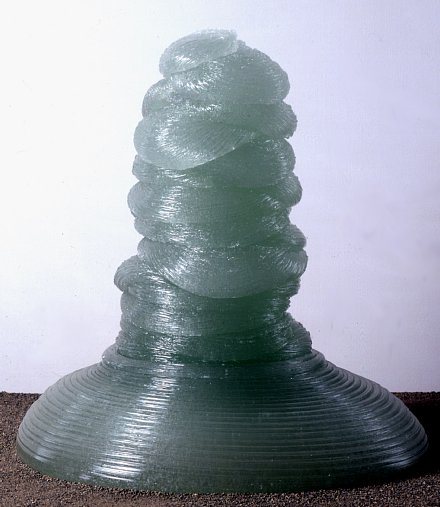| Kadonaga's Work Focuses on Process of Transitio By Holly Myers , Los Angeles Times - Art Review Monday, July 16, 2001 |
 |
| For gGlass No. 4E,h glass was melted and poured into spiraling piles. |
In
describing a body of artwork, the term "process-oriented" has a wide
range of possible implications. At worst, it is a label that excuses an artist
from the responsibility of creating a coherent final product. At best, however,
it describes a holistic approach to art-making that de-emphasizes the concept
of finality and at the same time uses the status of the final object to
encourage contemplation of the artistic process and the cyclical order of
nature.
The
work of Japanese artist Kazuo Kadonaga, currently on view at the Japanese
American Cultural and Community
Center, is process-oriented in the best sense. Painstakingly crafted from
elemental materials--bamboo, wood, paper and glass--the sculptures call
attention to the meditative labor involved in their construction yet also
reflect the organic patterns of nature. In one group of works, Kadonaga has
chiseled logs into long planks of wood that twist and curve as though moving to
some inner harmony. Although the handiwork of these objects is admirable in
itself, their forms seem not to have been devised by the artist but simply
released by him from some other shell. Most of the works in the exhibition have
a similar feeling of natural expression.
The materials Kadonaga uses
were among the first to be turned by human beings to utilitarian purposes.
Kadonaga calls attention to their changeability and the transitions they
undergo between physical states. One work is comprised of about a dozen
three-foot wooden rods that have been burned black at one end, embodying the
move from wood to charcoal. In another, a tree trunk has been sliced
into extremely thin sheets that lie together as though still part of the same
log--a clever encapsulation of the transition from wood to paper. Another group
involves large stacks of paper that are compressed into a tight block on one
end, as though part of a book, but that swell abruptly on the other end into a
large, pillowy mass, as if resisting the
confines to which the other half submits.
Kadonaga's
most recent works consist of green glass that has been melted and poured into
spiraling piles several feet high, an automated process that, according to
press materials, takes several days to complete and up to four months to cool
and solidify completely. Lit from above, the four works on display look like
otherworldly stalagmites, each similar in structure but unique in form. One is
almost perfectly round and nest-like, as though shaped on a pottery wheel;
another is rebelliously asymmetrical, a pile of fleshy folds that vaguely
resembles a pot-bellied Buddha figure. Each is topped with a pile of very thin
glass strands that resembles a bowl of clear rice noodles. Though clearly solid
and motionless, the works still seem liquid in nature; the hypnotic flow of molten
glass that is depicted in a video nearby seems, in the final product, not
stopped but merely suspended in motion.
Sadly, the gallery in which the sculptures are
installed is a poor venue for conveying the work's subtle elegance: An
awkwardly shaped, windowless space with badly stained gray carpet, it makes the
exhibition seem a bit like a lumber yard at first glance. Individually,
however, each work has a powerful, meditative presence--the clear result of
Kadonaga's solemn, even spiritual investment in the process of the work's
creation--that lulls the viewer into a harmonious state of identification.
George
J. Doizaki Gallery at the Japanese American Cultural and Community Center, 244
S. San Pedro,Los Angeles, (213)628-2725.
Through July 29.
Closed Mondays.